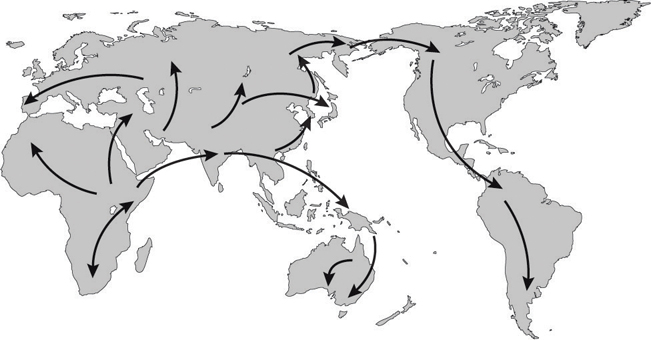
By now, the big picture of humanity's origins is pretty clear. Modern humans evolved in Africa over 100,000 years ago, but they took tens of thousands of years to leave the continent. Once they did, they rapidly spread across Asia and Australia, mating with some of the pre-modern (read: archaic) humans along the way.
But that big picture, often called "Out of Africa," has a number of details missing. For one, our understanding of the genetic diversity within Africa is startlingly bad—so bad that we missed an entirely distinct African Y chromosome lineage for decades. And there have been numerous debates about the number of times humanity has left Africa. Was it a single big migration, or did we depart in waves?
A new series of papers has narrowed the scope of the controversy considerably. While there may have been more than one push out of Africa, there's only one that really ended up mattering.
The archeological evidence for "Out of Africa" is pretty spotty. Modern humans first start showing up in the Mideast about 100,000 years ago, and there are a few intriguing skeletons and some sophisticated tools found even further into Asia. But clear evidence of the occupation of the rest of Asia doesn't show up until tens of thousands of years later, at which point humanity invaded everywhere from Europe to Australia in rapid succession.
There has been considerable debate over whether this evidence points to gradual expansion followed by a big push or simply a stunted migration that was held up in the neighborhood of Africa, awaiting the technological or genetic changes that made expansion possible.
To sort out these possibilities, we can either wait for archeological finds that may never come or try to understand what happened using the genetic legacy these events left behind in modern populations. To do the latter, we would need a better picture of exactly what that legacy is. That's where the series of papers in Nature come in, as they provide a much better picture of modern populations, using that information to infer what has happened in the past.
One of these papers looks in detail at the aboriginal populations of Australia and New Guinea. The ancestors of these populations seem to have come via a migration along the southern coasts of Asia and arrived in the area more than 40,000 years ago. This migration led to the suggestion that the ancestors represented a distinct out-of-Africa migration.
But the new data includes over 100 genomes from the modern descendants of these populations, and it indicates that the lineage is clearly part of the same group that expanded into Eurasia. The group did diverge from Eurasians more than 50,000 years ago, however—shortly after that out-of-Africa migration started. It may be that those who followed the southern route along the coast remained isolated from the rest of the expansion into Asia. As the authors of one of the papers put it, the data "suggests an early divergence of Australo-Papuans from the ancestors of all non-Africans, in agreement with two colonization waves across Asia."
Are there any indications of an earlier wave of modern humans? The paper described above appeared to find one in its initial analysis. But when the authors accounted for the presence of Neanderthal and Denisovan DNA, this hint went away. A second paper, based on fewer Aboriginals and more genomes from populations throughout Eurasia, found a hint that as much as two percent of the Aboriginal genomes may have originated from a modern human lineage that separated from African populations about 100,000 years ago. This discovery might be evidence of an earlier migration into Asia, but we'll probably have to wait for more focused analysis to sort the data out.
Meanwhile, another of the new papers looks at Africa itself. Here, some of the most genetically diverse (and therefore ancient) human populations appear to have separated from other African populations and non-Africans over 80,000 years ago. Another major split within African populations appears to have occurred just prior to the out-of-Africa migrations. Thus, while the major focus of research has been on non-African populations, there seems to have been just as much (if not more) going on inside of Africa.
It's important to note that this information doesn't rule out earlier migrations out of Africa. It's possible that earlier lineages spread through Eurasia as well. The data does indicate that there was one migration that really mattered, at about 50,000 years ago. The older populations, if they existed, either died out on their own or were displaced by these newcomers.
Relevant to that issue, one of the papers includes no genomes at all; instead, it relies on climate models. Two researchers at the University of Hawaii at Manoa have linked a model of human migrations to climate models that provide measures of things like water availability and plant life in earlier climates. They started off these models with conditions at 125,000 years ago, placing a human population in east Africa.
The results indicate that humans were stuck in Africa for at least 25,000 years, but climate conditions would allow multiple pulses of migration out starting at about 100,000 years ago. The problem is that these simulations also show that modern humans could have populated southern Europe by 80,000 years ago, and they could have been present in India and Southeast Asia as early as 90,000 years ago. There's no evidence, either archeological or genetic, indicating that either of these things happened.
Still, the models are consistent with some of the earliest signs of the presence of modern humans in the Mideast and Asia. But the genetic data now indicates that the legacy of any such populations is either slight or nonexistent. When it comes to leaving Africa, we're all one big family.
Nature, 2016. DOI: 10.1038/nature19792, 10.1038/nature18299, 10.1038/nature18964, 10.1038/nature19365 (About DOIs).
reader comments
128